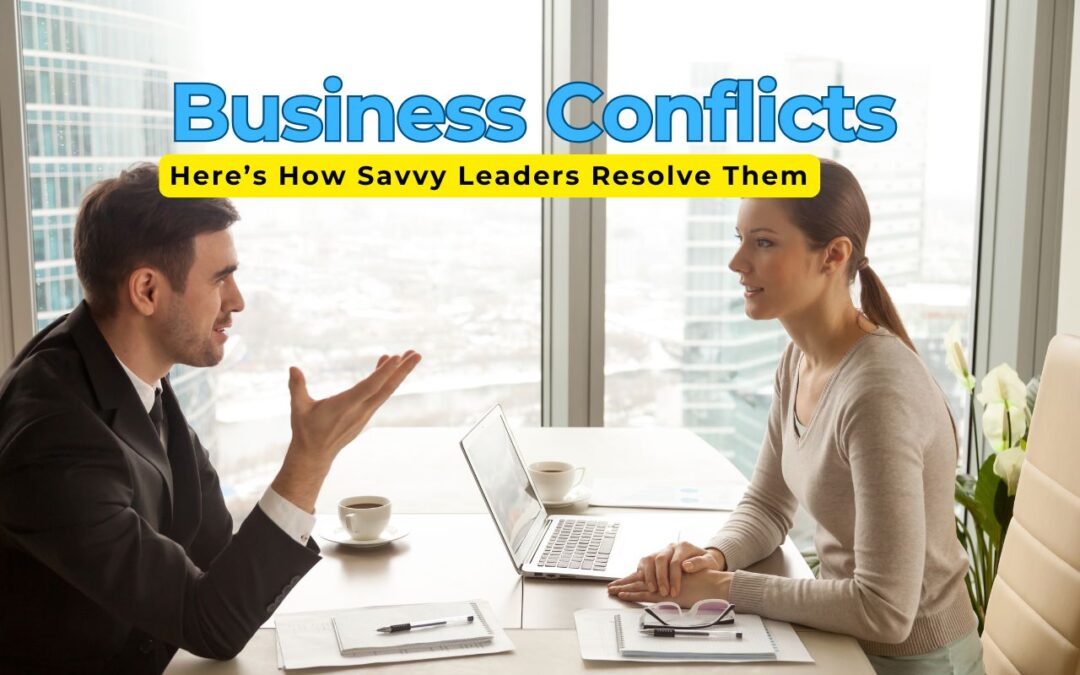You’ve created something amazing. Your team is working hard, your clients are engaged, and your business is moving forward – until a disagreement resurfaces. A disagreement with a co-founder, vendor, or even your team. The air goes tense, and you feel the pressure.This is where many leaders spiral out. But savvy leaders? They see opportunity.
The reality is that conflict will happen in business, but wars will not. How you deal with disagreements within business will either damage relationships or empower you as a leader, and often bring legitimacy. Let’s dive into how to positively and professionally resolve conflict in business without damage to relationships.
1. Identifying the Source of Business Conflicts
Most disputes don’t happen with yelling, letters from lawyers, or threats. They begin small: an assumption, missed expectations, or an unclear agreement. If you ignore them long enough, the tiniest crack can turn into an expensive fissure.
Common business disputes come from:
- Unaligned goals or ambiguous agreements
- A breakdown in communication
- Power struggles between teams or partners
- Differences in personality or leadership style
On identifying the source early, you can deal with it from a standpoint of clarity, rather than chaos.
2. Smart Leader Mindset: Calm and Curious
When a dispute arises, being human means you instinctively want to react or defend your position.In that moment, we become emotional, citing it’s painful and we’re not really thinking about returning to problem-solving mode.
Ask:
- What exactly is being said here?
- What does this person need to achieve?
- What am I not seeing?
The most intelligent leaders know there is emotion involved, and they allow it but don’t let that be the deciding factor. They lead with curiosity instead of ego.
3. Learn the Communication/Business Skills
Most conflicts arise as a result of poor communication. So the very first thing that you must do is communicate clearly, calmly, and with purpose.
Smart leaders communicate effectively by:
- Listening for understanding: Rather than just listening to respond.
- Using neutral language: Avoiding language that involves blame or escalates the situation
- Open-ended questions: Instead of accusing, ask in order to learn.
- When people feel like they have been heard sufficiently, the tension will go away on its own. That’s truly where resolution starts.
4. Look for Collaboration Rather than Winning
Conflict does not always require the pain of battle, but rather conflict can sometimes be a conversation that can create tension so as to lead to creative and long-lasting solutions.
Smart leaders are looking to achieve a win-win situation where both side leaves with dignity and forward movement. They would approach the conversation by trying to gain a great understanding of the issue and what both sides hear and then leverage that information, rather than trying to “win”:
- How can we work together, as collaborators, to solve this?
- What are we both missing around the common goal?
- Are there respect-based compromises that can be made by both?
The shift in mindset (from “me” to “me and you” against the subject matter in question) changes everything.
5. Mediation – When to Call in a Neutral Third Party
There are times when it is not possible for one not to be so. squeeze in effective and immediate solutions. This is where mediation can come into play.
- A trained, neutral mediator would help both parties:
- Keep the conversations productive
- Redirect the focus to shared goals
- Recommend, not dictate, fair compromises to consider
Smart leaders will always ask for help where required. Mediation isn’t a sign of weakness; it is a sign of wisdom. It is how many of our most prominent companies continue to work through their high-stakes disputes in an efficient and private way.
6. Avoid Problems with Pre-emptive Planning
Why wait for something to break down when you could have set things up right away?
Here’s how sensible leaders avert business conflicts before they start:
- Have clearly defined contracts and service agreements
- Clearly define roles, responsibilities, and expectations to get out of the gates strong
- Agree to “what if” scenarios before they happen
- Have a dispute resolution clause in business deals
Clarity breeds confidence. A prior planning before we start can save a lot of time, money, and headaches down the line.
7. Don’t Use Lawyers First
Legal disputes should be the last resort—not the first step. Court cases are expensive, public, and frequently destructive to relationships and brands.That said, savvy leaders know when to seek legal guidance:
- When a breach of contract takes place
- When a person’s behaviour goes against ethical or legal standards
- To review agreements or to prepare formal resolutions
- Legal advice is a tool, not a weapon. Use it wisely.
8. Learn and Evolve After Every Disagreement
After a conflict is resolved, take time to think about it:
- What was the primary reason for the issue?
- How did I contribute to it (directly or indirectly)?
- What improvements can we make to our process, communication, or leadership?
Conflicts are lessons. Great leaders take the business conflicts and use them to enhance their systems and strengthen their teams.
9. Your Leadership Influences Culture
How we respond to business conflicts will tell your culture. If your team sees you respond to conflict with calmness, fairness, and focus, they will. If they see you avoiding or exploding, they will replicate. Business conflict resolution is not just about being successful financially it also involves leading by example.
10. To Wrap Up: Conflict to Clarity
Disputes should not be feared, they are a part of growth. The difference between a fragile business and a resilient business is how the leadership responds.
In summary:
- Be calm and listen
- Task-based, not side-based
- Empathetic communication
- Collaborate for win-win
- Mediation or legal assistance when required
- Perform continuous learning and improvement
Conclusions
Next time things get difficult, just remember: you’re not supposed to win a battle, you are supposed to choose a better way to resolve it.













